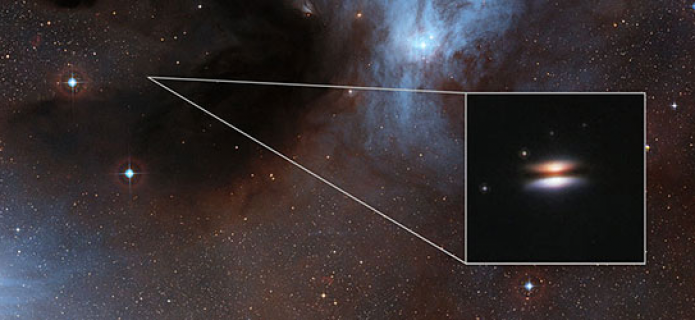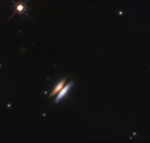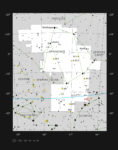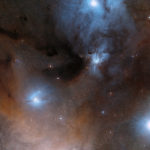The Frigid Flying Saucer
Astronomers have used the ALMA and IRAM telescopes to make the first direct measurement of the temperature of the large dust grains in the outer parts of a planet-forming disc around a young star. By applying a novel technique to observations of an object nicknamed the Flying Saucer they find that the grains are much colder than expected: –266 degrees Celsius. This surprising result suggests that models of these discs may need to be revised.
The international team, led by Stephane Guilloteau at the Laboratoire d'Astrophysique de Bordeaux, France, measured the temperature of large dust grains around the young star 2MASS J16281370-2431391 in the spectacular Rho Ophiuchi star formation region, about 400 light-years from Earth.
This star is surrounded by a disc of gas and dust — such discs are called protoplanetary discs as they are the early stages in the creation of planetary systems. This particular disc is seen nearly edge-on, and its appearance in visible light pictures has led to its being nicknamed the Flying Saucer.
The astronomers used the Atacama Large Millimeter/submillimeter Array (ALMA) to observe the glow coming from carbon monoxide molecules in the 2MASS J16281370-2431391 disc. They were able to create very sharp images and found something strange — in some cases they saw a negative signal! Normally a negative signal is physically impossible, but in this case there is an explanation, which leads to a surprising conclusion.
Zooming in on the Flying Saucer protoplanetary disc. This video takes us on a journey to the young star 2MASS J16281370-2431391 in the spectacular Rho Ophiuchi star formation region, about 400 light-years from Earth. This star is surrounded by a disc of gas and dust — a protoplanetary disc, the early stage in the creation of a planetary system. This particular disc is seen nearly edge-on, and its appearance in visible light pictures has led to its being nicknamed the Flying Saucer. The final close-up infrared view of the Flying Saucer comes from the NASA/ESA Hubble Space Telescope. Credit: ESO/N. Risinger (skysurvey.org)/S. Guisard (www.eso.org/~sguisard)/Digitized Sky Survey 2/NASA/ESA. Music: Johan B. Monell (www.johanmonell.com)
Lead author Stephane Guilloteau takes up the story: “This disc is not observed against a black and empty night sky. Instead it’s seen in silhouette in front of the glow of the Rho Ophiuchi Nebula. This diffuse glow is too extended to be detected by ALMA, but the disc absorbs it. The resulting negative signal means that parts of the disc are colder than the background. The Earth is quite literally in the shadow of the Flying Saucer!”
The team combined the ALMA measurements of the disc with observations of the background glow made with the IRAM 30-metre telescope in Spain [1]. They derived a disc dust grain temperature of only –266 degrees Celsius (only 7 degrees above absolute zero, or 7 Kelvin) at a distance of about 15 billion kilometers from the central star [2]. This is the first direct measurement of the temperature of large grains (with sizes of about one millimeter) in such objects.

The Flying Saucer protoplanetary disc around 2MASS J16281370-2431391. The young star 2MASS J16281370-2431391 lies in the spectacular Rho Ophiuchi star formation region, about 400 light-years from Earth. It is surrounded by a disc of gas and dust — such discs are called protoplanetary discs as they are the early stages in the creation of planetary systems. This particular disc is seen nearly edge-on, and its appearance in visible light pictures has led to its being nicknamed the Flying Saucer. The main image shows part of the Rho Ophiuchi region and a much enlarged close-up infrared view of the Flying Saucer from the NASA/ESA Hubble Space Telescope is shown as an insert. Credit: Digitized Sky Survey 2/NASA/ESA |
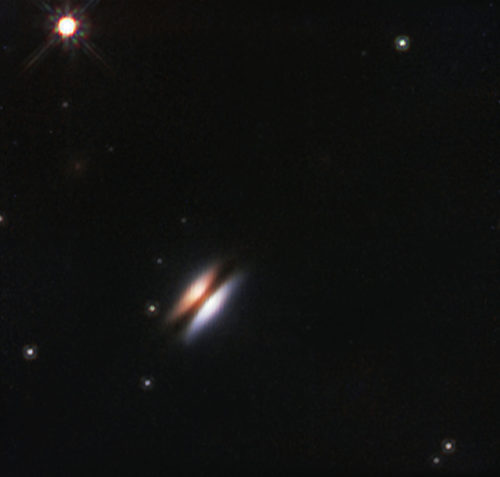
The Flying Saucer protoplanetary disc around 2MASS J16281370-2431391. This close-up infrared view of the Flying Saucer comes from the NASA/ESA Hubble Space Telescope. Credit: ESO/NASA/ESA
This temperature is much lower than the –258 to –253 degrees Celsius (15 to 20 Kelvin) that most current models predict. To resolve the discrepancy, the large dust grains must have different properties than those currently assumed, to allow them to cool down to such low temperatures.
“To work out the impact of this discovery on disc structure, we have to find what plausible dust properties can result in such low temperatures. We have a few ideas — for example the temperature may depend on grain size, with the bigger grains cooler than the smaller ones. But it is too early to be sure,” adds co-author Emmanuel di Folco (Laboratoire d'Astrophysique de Bordeaux).
If these low dust temperatures are found to be a normal feature of protoplanetary discs this may have many consequences for understanding how they form and evolve.

The Rho Ophiuchi star formation region in the constellation of Ophiuchus. This chart shows the large constellation of Ophiuchus (The Serpent Bearer). In the southern part of this constellation there is a spectacular region of dark and bright clouds, forming part of a region of star formation. This chart, which shows all the stars easily seen with the naked eye on a dark and clear night, shows the location of Rho Ophiuchi, the brightest star in the region. Credit: ESO, IAU and Sky & Telescope
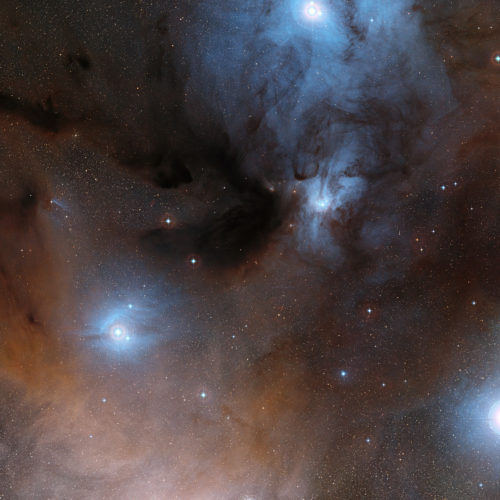
The Rho Ophiuchi star formation region in the constellation of Ophiuchus. This wide-field view shows a spectacular region of dark and bright clouds, forming part of a region of star formation in the constellation of Ophiuchus (The Serpent Bearer). This picture was created from images in the Digitized Sky Survey 2. Credit: ESO/Digitized Sky Survey 2
For example, different dust properties will affect what happens when these particles collide, and thus their role in providing the seeds for planet formation. Whether the required change in dust properties is significant or not in this respect cannot yet be assessed.
Low dust temperatures can also have a major impact for the smaller dusty discs that are known to exist. If these discs are composed of mostly larger, but cooler, grains than is currently supposed, this would mean that these compact discs can be arbitrarily massive, so could still form giant planets comparatively close to the central star.
Further observations are needed, but it seems that the cooler dust found by ALMA may have significant consequences for the understanding of protoplanetary discs.
Notes
[1] The IRAM measurements were needed as ALMA itself was not sensitive to the extended signal from the background.
[2] This corresponds to one hundred times the distance from the Earth to the Sun. This region is now occupied by the Kuiper Belt within the Solar System.
Additional information
This research was presented in a paper entitled “The shadow of the Flying Saucer: A very low temperature for large dust grains”, by S. Guilloteau et al., published in Astronomy & Astrophysics Letters.
The team is composed of S. Guilloteau (University of Bordeaux/CNRS, Floirac, France), V. Piétu (IRAM, Saint Martin d’Hères, France), E. Chapillon (University of Bordeaux/CNRS; IRAM), E. Di Folco (University of Bordeaux/CNRS), A. Dutrey (University of Bordeaux/CNRS), T.Henning (Max Planck Institute für Astronomie, Heidelberg, Germany [MPIA]), D.Semenov (MPIA), T.Birnstiel (MPIA) and N. Grosso (Observatoire Astronomique de Strasbourg, Strasbourg, France).
The Atacama Large Millimeter/submillimeter Array (ALMA), an international astronomy facility, is a partnership of the European Organisation for Astronomical Research in the Southern Hemisphere (ESO), the U.S. National Science Foundation (NSF) and the National Institutes of Natural Sciences (NINS) of Japan in cooperation with the Republic of Chile. ALMA is funded by ESO on behalf of its Member States, by NSF in cooperation with the National Research Council of Canada (NRC) and the Ministry of Science and Technology (MOST) in Taiwan and by NINS in cooperation with the Academia Sinica (AS) in Taiwan and the Korea Astronomy and Space Science Institute (KASI).
ALMA construction and operations are led by ESO on behalf of its Member States; by the National Radio Astronomy Observatory (NRAO), managed by Associated Universities, Inc. (AUI), on behalf of North America; and by the National Astronomical Observatory of Japan (NAOJ) on behalf of East Asia. The Joint ALMA Observatory (JAO) provides the unified leadership and management of the construction, commissioning and operation of ALMA.
Link
Contacts
Stephane Guilloteau
Laboratoire d'Astrophysique de Bordeaux
Floirac, France
Email: [email protected]
Emmanuel di Folco
Laboratoire d'Astrophysique de Bordeaux
Floirac, France
Email: [email protected]
Vincent Pietu
IRAM
Grenoble, France
Email: [email protected]
Valeria Foncea
Education and Public Outreach Officer
Joint ALMA Observatory
Santiago, Chile
Tel: +56 2 467 6258
Cell: +56 9 75871963
Email: [email protected]
Richard Hook
Public Information Officer, ESO
Garching bei München, Germany
Tel: +49 89 3200 6655
Cell: +49 151 1537 3591
Email: [email protected]
Charles E. Blue
Public Information Officer
National Radio Astronomy Observatory
Charlottesville, Virginia, USA
Tel: +1 434 296 0314
Cell: +1 202 236 6324
E-mail: [email protected]
Masaaki Hiramatsu
Education and Public Outreach Officer, NAOJ Chile
Observatory
Tokyo, Japan
Tel: +81 422 34 3630
E-mail: [email protected]
